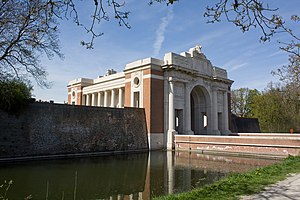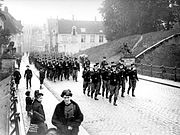| Menin Gate Memorial to the Missing | |
|---|---|
| Commonwealth War Graves Commission | |
 The Menin Gate | |
| For the missing of Commonwealth nations (except New Zealand and Newfoundland) who died in the Ypres Salient during the First World War. | |
| Unveiled | 24 July 1927 |
| Location |
50°51′07.6″N 02°53′30.1″E / 50.852111°N 2.891694°ECoordinates: 50°51′07.6″N 02°53′30.1″E / 50.852111°N 2.891694°E near Ypres, West Flanders, Belgium |
| Designed by | Reginald Blomfield |
| Total commemorated | 54,896 |
| Burials by nation | |
| |
| Burials by war | |
|
World War I: 54,896 | |
| To the armies of the British Empire who stood here from 1914 to 1918 and to those of their dead who have no known grave | |
Statistics source:
| |
The Menin Gate Memorial to the Missing is a war memorial in Ypres, Belgium dedicated to the British and Commonwealth soldiers who were killed in the Ypres Salient of World War I and whose graves are unknown. The memorial is located at the eastern exit of the town and marks the starting point for one of the main roads out of the town that led Allied soldiers to the front line. Designed by Sir Reginald Blomfield and built by the British government, the Menin Gate Memorial was unveiled on 24 July 1927.[1]
Background[]

Menenpoort at the start of World War I
In medieval times, the original narrow gateway on the eastern side of the city of Ypres was called the Hangoartpoort, "poort" being the Flemish word for gate. In order to prosper and maintain its wealth, the city of Ypres had to be fortified, to keep out potential invaders. During the 17th and 18th centuries, while under the occupation of the Habsburgs and the French, the city was increasingly fortified. Major works were completed at the end of the 17th century by the French military engineer Sebastien Le Prestre, Seigneur de Vauban. At the outbreak of the First World War in August 1914, the eastern exit simply cut through the remains of the ramparts and crossed a moat. The gateway was by this time known as the Menenpoort, or Menin Gate in English, because the road leading through the gateway led to the small town of Menen.
Ypres occupied a strategic position during the First World War because it stood in the path of Germany's planned sweep across the rest of Belgium, as had been called for in the Schlieffen Plan. By October 1914, the much battered Belgian Army broke the dykes on the Yser River to the north of the City to keep the western tip of Belgium out of German hands. Ypres, being the centre of a road network, anchored one end of this defensive feature and was also essential for the Germans if they wanted to take the Channel Ports through which British support was flooding into France. For the Allies, Ypres was also important because it eventually became the last major Belgian town that was not under German control.
The importance of the town is reflected in the five major battles that occurred around it during the war. During the First Battle of Ypres the Allies halted the German Army's advance to the east of the city. The German army eventually surrounded the city on three sides, bombarding it throughout much of the war. The Second Battle of Ypres marked a second German attempt to take the city in April 1915. The third battle is more commonly referred to as Passchendaele, but this 1917 battle was a complex five month engagement. The fourth and fifth battles occurred during 1918.
British and Commonwealth soldiers often passed through the Menenpoort on their way to the front lines with some 300,000 of them being killed in the Ypres Salient. Of these, 90,000 of these soldiers have no known graves. The carved limestone lions adorning the original gate were damaged by shellfire, and were donated to the Australian War Memorial by the Mayor of Ypres in 1936. They were restored in 1987, and currently reside at the entrance to that Memorial, so that all visitors to the Memorial pass between them.[2]
Memorial[]

Interior, Menin Gate

Image of the name of Sgt. Robert O'Connor of The Leinster Regiment on the Menin Gate wall, who was killed on the July 31, 1917 during the Third Battle of Passchendaele
Reginald Blomfield's triumphal arch, designed in 1921, is the entry to the barrel-vaulted passage for traffic through the mausoleum that honours the Missing, who have no known graves. The patient lion on the top is the lion of Britain but also the lion of Flanders. It was chosen to be a memorial as it was the closest gate of the town to the fighting, and so Allied Troops would have marched past it on their way to fight. Actually, most troops passed out of the other gates of Ypres, as the Menin Gate was too dangerous due to shellfire.
Its large Hall of Memory contains names on stone panels of 54,896 Commonwealth soldiers who died in the Salient but whose bodies have never been identified or found. On completion of the memorial, it was discovered to be too small to contain all the names as originally planned. An arbitrary cut-off point of 15 August 1917 was chosen and the names of 34,984 UK missing after this date were inscribed on the Tyne Cot Memorial to the Missing instead. The Menin Gate Memorial does not list the names of the missing of New Zealand and Newfoundland soldiers, who are instead honoured on separate memorials.
The inscription inside the archway is similar to the one at Tyne Cot, with the addition of a prefatory Latin phrase: "Ad Majorem Dei Gloriam - Here are recorded names of officers and men who fell in Ypres Salient, but to whom the fortune of war denied the known and honoured burial given to their comrades in death". The Latin phrase means 'To the greater glory of God'. Both this inscription, and the main overhead inscription on both the east- and west-facing facades of the arch, were composed by Rudyard Kipling.[3] On the opposite side of the archway to that inscription is the shorter dedication: "They shall receive a crown of glory that fadeth not away". There are also Latin inscriptions set in circular panels either side of the archway, on both the east and west sides: "Pro Patria" and "Pro Rege" ('For Country' and 'For King'). A French inscription mentions the citizens of Ypres: "Erigé par les nations de l'Empire Britannique en l'honneur de leurs morts ce monument est offert aux citoyens d'Ypres pour l'ornement de leur cité et en commémoration des jours où l'Armée Britannique l'a défendue contre l'envahisseur", which translated into English means: "Erected by the nations of the British Empire in honour of their dead this monument is offered to the citizens of Ypres for the ornament of their city and in commemoration of the days where the British Army defended it against the invader."[4][5]
Reaction to the Menin Gate, the first of the Imperial War Graves Commission's Memorials to the Missing, ranged from its condemnation by the war poet Siegfried Sassoon, to praise by the Austrian writer Stefan Zweig. Sassoon described the Menin Gate in his poem 'On Passing the New Menin Gate', saying that the dead of the Ypres Salient would "deride this sepulchre of crime". Zweig, in contrast, praised the simplicity of the memorial, and lack of overt triumphalism, and said that it was "more impressive than any triumphal arch or monument to victory that I have ever seen". Blomfield himself said that this work of his was one of three that he wanted to be remembered by.[6]
To this day, the remains of missing soldiers are still found in the countryside around the town of Ypres. Typically, such finds are made during building work or road-mending activities. Any human remains discovered receive a proper burial in one of the war cemeteries in the region. If the remains can be identified, the relevant name is removed from the Menin Gate[citation needed].
"Last Post" ceremony[]
Crowds gather at the "Last Post" ceremony
Following the Menin Gate Memorial opening in 1927, the citizens of Ypres wanted to express their gratitude towards those who had given their lives for Belgium's freedom. As such, every evening at 20:00, buglers from the local fire brigade close the road which passes under the memorial and sound the "Last Post".[7] Except for the occupation by the Germans in World War II when the daily ceremony was conducted at Brookwood Military Cemetery, in Surrey, England, this ceremony has been carried on uninterrupted since 2 July 1928.[8] On the evening that Polish forces liberated Ypres in the Second World War, the ceremony was resumed at the Menin Gate despite the fact that heavy fighting was still taking place in other parts of the town.
See also[]
- Missing in action
- The Thiepval Memorial
References[]
- ↑ Jacqueline Hucker. "Monuments of the First and Second World Wars". The Canadian Encyclopedia. http://www.thecanadianencyclopedia.com/index.cfm?PgNm=TCE&Params=A1ARTA0009128. Retrieved 2011-11-21.
- ↑ Elizabeth Burness (October 1988). "Menin Gate lions". Journal of the Australian War Memorial 13. Australian War Memorial. pp. 48–49. http://www.awm.gov.au/encyclopedia/menin/lions.asp.
- ↑ What does the Menin Gate look like?, Their Past Your Future, Imperial War Museum, November 2005, accessed 07/02/2010
- ↑ Menepoort, Belgian World Heritage Sites entry, accessed 07/02/2010
- ↑ Last Post - Menenpoort - Ieper, Forum Eerste Wereldoorlog, accessed 07/02/2010. The information is attributed to three sources: Dominiek Dendooven – Documentatiecentrum In Flanders Fields (In Flanders Fields Magazine); Dominiek Dendooven – Documentatiecentrum In Flanders Fields 'Menenpoort & Last Post'; Jabobs M., "Zij, die vielen als helden", Brugge, 1996, 2 volumes - Uitgave Provincie West-Vlaanderen.
- ↑ The Memorial to the Missing of the Somme (Gavin Stamp, 2007), pages 103-105
- ↑ "Last Poster Association - Ceremonies". http://www.lastpost.be/en/x/58/ceremonies.
- ↑ "Last Post Association Ieper". http://www.lastpost.be/en/index/index/slug/home.
External links[]
| Wikimedia Commons has media related to Menin Gate. |
- The Official Last Post Website
- Tom Morgan, "The Menin Gate, Ypres", with an excerpt from Lord Plumer's moving dedicatory address
- Siegfried Sassoon On Passing the new Menin Gate
- Menenpoort (Belgian heritage register)
| ||||||||||||||||||||||||
The original article can be found at Menin Gate and the edit history here.